HFC Switching
Chuck Kaplan, Narad Networks Telecommunications networks have used switched architectures for more than 100 years, so why haven’t cable operators, and more importantly, why are they looking at them now? Historically, cable’s niche was to improve reception of over-the-air broadcast signals. It didn’t need the full functionality of a telecom system. But the success of high-speed data, the advent of voice and increasingly sophisticated video services, and the expansion of competitive fields to include residential and business customers have strengthened the case for switched architectures. Wired and wireless voice and business data services, for instance, have increased cable’s addressable market roughly three-fold. Operators are a long way from the original, improved broadcast solution. Toward symmetry The next-generation needs of cable networks are expanding. The symmetric traffic capacity of the HFC network must grow by orders of magnitude to serve the planned and unplanned needs of the coming decades. Superior economics in the deployment of this traffic capacity growth must be achieved, including a funding model acceptable to investors and corporate leadership. A clear cost/benefit advantage over competing networks must be demonstrated as fiber to the "X" (FTTx) networks are constructed. The current HFC network is very asymmetric. To illustrate this, assume the usable upstream spectrum per node is 25 MHz wide, allowing up to 80 Mbps of upstream capacity at 16-QAM (quadrature amplitude modulation). The downstream spectrum in an 860 MHz network is about 810 MHz wide, yielding more than 5,700 Mbps of downstream capacity (if it were all digital capacity) at 256-QAM. So the downstream is about 71 times larger than the upstream. How will the cable network expand its symmetric capacities by orders of magnitude, and do so in a way that is funded according to metrics of free cash flow and tightly managed capex and opex? The telephone companies are building brand new access networks, but cable operators cannot, largely because the HFC upgrades of the past 15 years are just ending. How, then, does a cable operator achieve this objective and still outperform a new fiber to the home (FTTH) telco network, both now and later after competition has escalated? The starting point is to examine the existing HFC network. The existing model The HFC network model is similar to a tree: Fiber leads to coaxial cable trunks, which lead to coaxial cable branches and finally to coaxial cable drops. This tree, however, does not form a true hierarchy because the capacity carried in the fiber section is the same as that carried in the coaxial cable trunks, branches and drops. Thus, the current HFC access network uses downstream broadcasting with a reverse path time division multiple access (TDMA) contention resolution. Even though the fiber technically has a huge amount of capacity, the fact that there is no intelligence at any junction in the access network means that the fiber will carry no more than the coaxial cable trunks and drops south of the node. In fact, the traffic carried downstream in the most distant coaxial cable drop is identical to the traffic carried in the fiber that feeds the node. Likewise, traffic originating at the endpoints (the customer premises) of the HFC network and flowing upstream will also be duplicated in each successive northbound link. And the upstream has contention and capacity to deal with. The contention issue resembles the situation of multiple trains sharing tracks: Upstream packets must not arrive at the same place at the same time lest they collide. There are other problems relative to HFC upstream capacity. The upstream spectral slot is inherently noisy, has a narrow spectrum band, and RF noise aggregates (funnels) additively at northbound physical junctions. These factors combine to limit the upstream traffic capacity when compared to downstream capacity. Headend and node A switched HFC solution can be fed by dedicated fibers to the node or by wavelength division multiplexing (WDM) links over fiber that is already in use. Many nodes today have very few, if any, spare fibers. Moreover, the cost to construct new fibers to the node is very high because these fibers extend from a regional hub, a distance often measuring tens of kilometers. There are, however, spare wavelengths on these existing fibers, and Gigabit Ethernet (GigE) or 10GigE can be transported on these existing fibers using relatively inexpensive, environmentally hardened WDM multiplexers. Starting at the fiber node, a switch can be placed in parallel with the existing fiber node. Using a WDM mux, 1 Gbps or 10 Gbps of additional, bidirectional Ethernet traffic is fed to and from the node switch. This traffic is then intelligently switched onto southbound fiber trunks or coaxial cable trunks from the node (Figure 1). 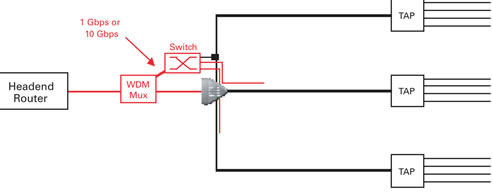 This is the first major point of departure from the broadcast network: Each southbound trunk (fiber or coax) will carry different traffic. Furthermore, since the fiber to the node has much more traffic capacity than the subordinate trunks, a true hierarchy is created. It is important to note that this hierarchy (a feeder with more capacity than trunks) is what allows for significant capacity expansion. The switch must also have sufficient processing speed to distribute that capacity in parallel to all trunks. This leads to some principles of switching as applied to HFC. The network forms a true hierarchy-northbound fiber carries greater capacity than southbound trunks-and a southbound trunk is not burdened with traffic that doesn’t belong in it. This principle is the same one used in switched broadcast video. A video stream is only sent down a path to an end user that will use that particular stream, thus improving bandwidth efficiency. Figures 2 and 3 illustrate the differences between broadcasting (every segment of the network has exactly the same traffic and the same capacities) and switching (segments carry different traffic in parallel.)
This is the first major point of departure from the broadcast network: Each southbound trunk (fiber or coax) will carry different traffic. Furthermore, since the fiber to the node has much more traffic capacity than the subordinate trunks, a true hierarchy is created. It is important to note that this hierarchy (a feeder with more capacity than trunks) is what allows for significant capacity expansion. The switch must also have sufficient processing speed to distribute that capacity in parallel to all trunks. This leads to some principles of switching as applied to HFC. The network forms a true hierarchy-northbound fiber carries greater capacity than southbound trunks-and a southbound trunk is not burdened with traffic that doesn’t belong in it. This principle is the same one used in switched broadcast video. A video stream is only sent down a path to an end user that will use that particular stream, thus improving bandwidth efficiency. Figures 2 and 3 illustrate the differences between broadcasting (every segment of the network has exactly the same traffic and the same capacities) and switching (segments carry different traffic in parallel.) 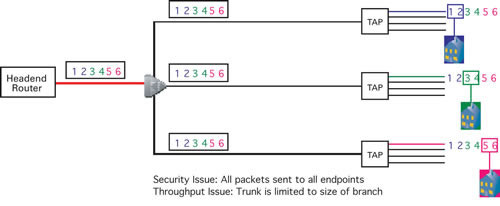 As shown in Figure 3, the switched architecture results not only in better throughput capacity but also has an inherent security value by not sending data to end users who should not receive it.
As shown in Figure 3, the switched architecture results not only in better throughput capacity but also has an inherent security value by not sending data to end users who should not receive it. 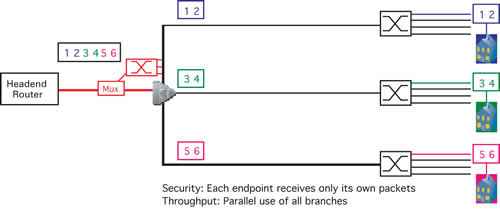 In terms of scalability, the use of WDM to carry GigE or 10GigE to the node creates a virtually unlimited supply of symmetric traffic to/from the node. When the peak demand of the traffic carried on the fiber trunks exceeds its current capacity, either a faster GigE transceiver is plugged in or two more wavelengths are put into use. Thus, a 1 Gbps gigabit interface converter (GBIC) can be replaced with a 10 Gbps GBIC, or another GBIC can be added. Assuming a customary coarse WDM (CWDM) environment with 16 wavelengths available, this yields about 80 Gbps of symmetric traffic per node on each of the existing fibers leading to the node. At the tap or curb When looking at the tapping location (the curb), issues of upstream packet contention and downstream packet security are raised. Since HFC is a tree-and-branch structure, upstream packets would collide at the junction points where branches come together. Therefore, a contention management scheme (typically TDMA) is used to prevent collisions. And since a broadcast network has no way to differentiate the traffic on either side of any junction, the upstream traffic from any endpoint within any given frequency slot must have exclusive use of the entire node at any given moment, giving rise to these issues (Figure 4):
In terms of scalability, the use of WDM to carry GigE or 10GigE to the node creates a virtually unlimited supply of symmetric traffic to/from the node. When the peak demand of the traffic carried on the fiber trunks exceeds its current capacity, either a faster GigE transceiver is plugged in or two more wavelengths are put into use. Thus, a 1 Gbps gigabit interface converter (GBIC) can be replaced with a 10 Gbps GBIC, or another GBIC can be added. Assuming a customary coarse WDM (CWDM) environment with 16 wavelengths available, this yields about 80 Gbps of symmetric traffic per node on each of the existing fibers leading to the node. At the tap or curb When looking at the tapping location (the curb), issues of upstream packet contention and downstream packet security are raised. Since HFC is a tree-and-branch structure, upstream packets would collide at the junction points where branches come together. Therefore, a contention management scheme (typically TDMA) is used to prevent collisions. And since a broadcast network has no way to differentiate the traffic on either side of any junction, the upstream traffic from any endpoint within any given frequency slot must have exclusive use of the entire node at any given moment, giving rise to these issues (Figure 4): 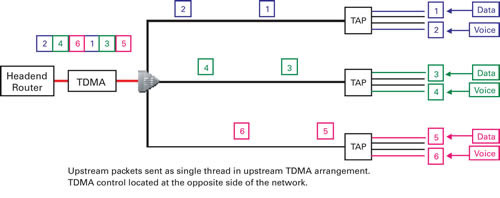 -Contention management occurs at the opposite end of the network from the actual collision points, resulting in inefficiencies and packet latency. -Endpoints must wait for their turn to transmit upstream, resulting in capacity limits and packet latency. Switching at the curb, or ingress point of a network, illustrates the ability of the switch to resolve upstream contention at the outer edge of the access network. When a switch is placed at the curb, upstream packet contention is resolved before the traffic enters the shared portions of the HFC network. Here the switch performs collision management as well as packet prioritization to ensure that delay-sensitive packets precede other packets. The use of switches at the curb illustrates three more principles of the switched topology on HFC: -Downstream security is ensured because only the packets intended for a given endpoint are switched to that endpoint. -Upstream contention is resolved at the earliest possible point, namely at the ingress point. -Packet prioritization rules are enforced in every switch so that packets are sent in the right order. Figure 5 illustrates upstream contention management and prioritization as well as downstream security. A sufficiently fast curb-switch will take parallel inputs from the many coax drops and intelligently reorder these into serial flows heading upstream. Contention is resolved nearly instantaneously. Curb-switching results in end-to-end latency of less than 5 ms. By contrast, end-to-end latency in TDMA networks is on the order of 50 ms.
-Contention management occurs at the opposite end of the network from the actual collision points, resulting in inefficiencies and packet latency. -Endpoints must wait for their turn to transmit upstream, resulting in capacity limits and packet latency. Switching at the curb, or ingress point of a network, illustrates the ability of the switch to resolve upstream contention at the outer edge of the access network. When a switch is placed at the curb, upstream packet contention is resolved before the traffic enters the shared portions of the HFC network. Here the switch performs collision management as well as packet prioritization to ensure that delay-sensitive packets precede other packets. The use of switches at the curb illustrates three more principles of the switched topology on HFC: -Downstream security is ensured because only the packets intended for a given endpoint are switched to that endpoint. -Upstream contention is resolved at the earliest possible point, namely at the ingress point. -Packet prioritization rules are enforced in every switch so that packets are sent in the right order. Figure 5 illustrates upstream contention management and prioritization as well as downstream security. A sufficiently fast curb-switch will take parallel inputs from the many coax drops and intelligently reorder these into serial flows heading upstream. Contention is resolved nearly instantaneously. Curb-switching results in end-to-end latency of less than 5 ms. By contrast, end-to-end latency in TDMA networks is on the order of 50 ms. 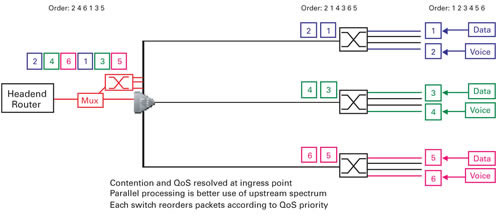 In the middle Finally, the node-switching and curb-switching concepts also apply to intermediate switches between the node and the curb. Adding additional trunk switches south of the node switch will have the effect of splitting nodes. Thus, each switch south of the node switch becomes its own mini-node serving a smaller set of endpoints. Fiber trunking between the node-switch and these intermediate nodes ensures that the traffic capacity of the entire node is correctly transported and shared according to traffic management or service level agreement (SLA) rules. And the southward march of switches can be dynamically triggered based on capacity demand. The deployment of switches in success-based fashion also creates a favorable economic model. Deep fiber U.S. telcos are now constructing deep fiber networks, with dedicated speeds in the 35 Mbps range. This raises the question about cable operators’ competitive response. The use of switches in the HFC access network can be an implementation of fiber to the curb (FTTC) that leverages the existing HFC network, as shown in Figure 6. The economics are very favorable because the existing fiber to the node is used for 10GigE over WDM, and the existing coaxial cable drops are used with no additional construction.
In the middle Finally, the node-switching and curb-switching concepts also apply to intermediate switches between the node and the curb. Adding additional trunk switches south of the node switch will have the effect of splitting nodes. Thus, each switch south of the node switch becomes its own mini-node serving a smaller set of endpoints. Fiber trunking between the node-switch and these intermediate nodes ensures that the traffic capacity of the entire node is correctly transported and shared according to traffic management or service level agreement (SLA) rules. And the southward march of switches can be dynamically triggered based on capacity demand. The deployment of switches in success-based fashion also creates a favorable economic model. Deep fiber U.S. telcos are now constructing deep fiber networks, with dedicated speeds in the 35 Mbps range. This raises the question about cable operators’ competitive response. The use of switches in the HFC access network can be an implementation of fiber to the curb (FTTC) that leverages the existing HFC network, as shown in Figure 6. The economics are very favorable because the existing fiber to the node is used for 10GigE over WDM, and the existing coaxial cable drops are used with no additional construction. 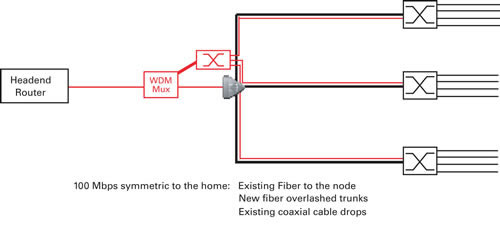 "Lego" economics Another important aspect of switching is the ability to change media at the switch point. In this sense, an airport can be thought of as a switch. A plane carries the passenger to the airport, and then the passenger decides (the intelligence function) to take the next path via train or car or bus or another plane. Similarly, since a switch can accommodate many different kinds of physical ports that are separated by the switching fabric, the decision of which physical path to use can be determined case-by-case based on economics. Thus, when adding a switch at the curb to serve a customer, if there is an existing coaxial cable drop, then using this drop will be less expensive than building a new one. When there is no wired drop cable at all, it may be more cost-effective to add a wireless plant extension from the curb-switch. Or when expanding trunk capacity by deploying switches along a central thoroughfare, if there is an impediment such as an underground construction blockage, it may make sense to use existing coax trunks rather than constructing new fiber. The switch makes all of these choices available, and the choice of physical media for the next link is a matter of selecting the desired type of port at the switch. The so-called "Lego" mode (flexibly snap on the next piece as needed) has not only the advantages of capex and opex optimization but also a time-to-market advantage. Many competitive situations will be won or lost by the provider that can execute a faster install. And in many cases, return on investment (ROI) is dramatically improved by the increased time-to-revenue. If a fiber link construction will take months to build, then a wireless link can be used temporarily while the fiber is being constructed, all emanating from the same switch and being managed by the same traffic management system. In the case of a three-month construction delay, the use of an existing coaxial cable or a wireless plant extension can be paid for during the time it would take to construct new plant. Monitor and win Because a switch is an intelligent device with communication paths, each switch is also a network monitor. The switch is the ideal entity to report network health to a network manager. Switch-generated reports on issues such as bit errors, power outages, and RF power fluctuations can alert maintenance personnel instantaneously to the problem and its exact location. A switch thus can lead to the proactive resolution of network problems. This monitoring function is critical in the deployment of business services to enterprises of all sizes and is becoming more important in competitive residential networks. In the next generation of the telecom industry, the battle for the home, office and mobility will be fought, and market shares will shift. The stakes are high, and competition is very real and multidimensional. The HFC network can readily evolve into a switched network; in doing so, it will achieve economics and performance against which the telephone companies cannot compete effectively. In the end, intelligent, switched networks win. Chuck Kaplan is COO of Narad Networks. Reach him at kaplanc@naradnetworks.com.
"Lego" economics Another important aspect of switching is the ability to change media at the switch point. In this sense, an airport can be thought of as a switch. A plane carries the passenger to the airport, and then the passenger decides (the intelligence function) to take the next path via train or car or bus or another plane. Similarly, since a switch can accommodate many different kinds of physical ports that are separated by the switching fabric, the decision of which physical path to use can be determined case-by-case based on economics. Thus, when adding a switch at the curb to serve a customer, if there is an existing coaxial cable drop, then using this drop will be less expensive than building a new one. When there is no wired drop cable at all, it may be more cost-effective to add a wireless plant extension from the curb-switch. Or when expanding trunk capacity by deploying switches along a central thoroughfare, if there is an impediment such as an underground construction blockage, it may make sense to use existing coax trunks rather than constructing new fiber. The switch makes all of these choices available, and the choice of physical media for the next link is a matter of selecting the desired type of port at the switch. The so-called "Lego" mode (flexibly snap on the next piece as needed) has not only the advantages of capex and opex optimization but also a time-to-market advantage. Many competitive situations will be won or lost by the provider that can execute a faster install. And in many cases, return on investment (ROI) is dramatically improved by the increased time-to-revenue. If a fiber link construction will take months to build, then a wireless link can be used temporarily while the fiber is being constructed, all emanating from the same switch and being managed by the same traffic management system. In the case of a three-month construction delay, the use of an existing coaxial cable or a wireless plant extension can be paid for during the time it would take to construct new plant. Monitor and win Because a switch is an intelligent device with communication paths, each switch is also a network monitor. The switch is the ideal entity to report network health to a network manager. Switch-generated reports on issues such as bit errors, power outages, and RF power fluctuations can alert maintenance personnel instantaneously to the problem and its exact location. A switch thus can lead to the proactive resolution of network problems. This monitoring function is critical in the deployment of business services to enterprises of all sizes and is becoming more important in competitive residential networks. In the next generation of the telecom industry, the battle for the home, office and mobility will be fought, and market shares will shift. The stakes are high, and competition is very real and multidimensional. The HFC network can readily evolve into a switched network; in doing so, it will achieve economics and performance against which the telephone companies cannot compete effectively. In the end, intelligent, switched networks win. Chuck Kaplan is COO of Narad Networks. Reach him at kaplanc@naradnetworks.com.